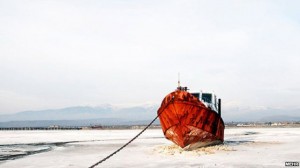 TEHRAN (Tasnim) � Head of the Department of Environment (DOE) Masoumeh Ebtakar and Energy Minister Hamid Chitchian are to visit Lake Oroumiyeh to see first hand the current condition of the endangered natural habitat and to look for solutions to reverse the crisis in that water basin.
TEHRAN (Tasnim) � Head of the Department of Environment (DOE) Masoumeh Ebtakar and Energy Minister Hamid Chitchian are to visit Lake Oroumiyeh to see first hand the current condition of the endangered natural habitat and to look for solutions to reverse the crisis in that water basin.As Lake Oroumiyeh is shrinking and deserts of salt expanding, Iranian officilas are trying to find ways to avert an imminent disaster and to stop the world�s third largest salt lake from drying up.
Masoumeh Ebtakar, who was appointed as head of the Department of Environment a couple of days ago, and energy minister are to travel to the area to see the extent of the problem and to study ways of reversing the situation.
The two top government officials are also scheduled to attend an important meeting in West Azarbaijan province, in which the latest revival plans for Oroumiyeh Lake will be scrutinized.
The Iranian Department of Environment has a special plan for saving the Oroumiyeh Lake and wants to make sure it can help arrest the crisis and revert the late to its previous situation, vice president and head of DOE said Wednesday.
�In the first session of the cabinet, there was a ratification on saving the Oroumiyeh Lake, which is to be followed up by the Energy Ministry and Energy Minister Hamid Chitchian ,� Masoumeh Ebtekar said in a meeting with the press.
She added that the Department of Environment is definitely pursuing the matter till revival of that national lake.
Oroumiyeh Lake is a salt lake in northwestern Iran near Iran�s border with Turkey.
The lake is between the Iranian provinces of East Azarbaijan province and West Azarbaijan, west of the southern portion of the similarly shaped Caspian Sea.
It is the largest lake in the Middle East, and the third largest saltwater lake on earth, with a surface area of approximately 5,200 square kilometers, and is protected as a national park by the Iranian Department of Environment. But it has shrunk by 60% and could disappear entirely in just a few years, due to persistent drought, misguided irrigation policies, and the damming of rivers that feed it.
By Tasnim News Agency
The Iran Project is not responsible for the content of quoted articles.










